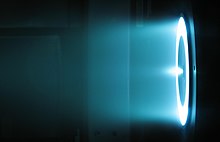
Spacecraft electric propulsion (or just electric propulsion) is a type of spacecraft propulsion technique that uses electrostatic or electromagnetic fields to accelerate mass to high speed and thus generating thrust to modify the velocity of a spacecraft in orbit.[1] The propulsion system is controlled by power electronics.
Electric thrusters typically use much less propellant than chemical rockets because they have a higher exhaust speed (operate at a higher specific impulse) than chemical rockets.[1] Due to limited electric power the thrust is much weaker compared to chemical rockets, but electric propulsion can provide thrust for a longer time.[2]
Electric propulsion was first demonstrated in the 1960s and is now a mature and widely used technology on spacecraft. American and Russian satellites have used electric propulsion for decades.[3] As of 2019[update], over 500 spacecraft operated throughout the Solar System use electric propulsion for station keeping, orbit raising, or primary propulsion.[4] In the future, the most advanced electric thrusters may be able to impart a delta-v of 100 km/s (62 mi/s), which is enough to take a spacecraft to the outer planets of the Solar System (with nuclear power), but is insufficient for interstellar travel.[1][5] An electric rocket with an external power source (transmissible through laser on the photovoltaic panels) has a theoretical possibility for interstellar flight.[6][7] However, electric propulsion is not suitable for launches from the Earth's surface, as it offers too little thrust.
On a journey to Mars, an electrically powered ship might be able to carry 70% of its initial mass to the destination, while a chemical rocket could carry only a few percent.[8]
- ^ a b c Choueiri, Edgar Y. (2009) New dawn of electric rocket Scientific American 300, 58–65 doi:10.1038/scientificamerican0209-58
- ^ "Electric versus Chemical Propulsion". Electric Spacecraft Propulsion. ESA. Retrieved 17 February 2007.
- ^ "Electric Propulsion Research at Institute of Fundamental Technological Research". 16 August 2011. Archived from the original on 16 August 2011.
- ^ Lev, Dan; Myers, Roger M.; Lemmer, Kristina M.; Kolbeck, Jonathan; Koizumi, Hiroyuki; Polzin, Kurt (June 2019). "The technological and commercial expansion of electric propulsion". Acta Astronautica. 159: 213–227. Bibcode:2019AcAau.159..213L. doi:10.1016/j.actaastro.2019.03.058. S2CID 115682651.
- ^ "Choueiri, Edgar Y. (2009). New dawn of electric rocket".
- ^ "Google Scholar". scholar.google.com.
- ^ Geoffrey A. Landis. Laser-powered Interstellar Probe Archived 22 July 2012 at the Wayback Machine on the Geoffrey A. Landis: Science. papers available on the web
- ^ Boyle, Alan (29 June 2017). "MSNW's plasma thruster just might fire up Congress at hearing on space propulsion". GeekWire. Retrieved 15 August 2021.